Jan 20, 2023
How to Make your Digital Marketing More Inclusive for Neurodivergent Consumers
In today’s marketing world, diversity and inclusion in many different areas have become a much more important consideration for brands as well as employers, with many starting to hold themselves accountable and put genuine measures in place. Digital accessibility is the principle of ensuring those with disabilities, such as sight or hearing loss. But many people - like neurodivergent people - have a hidden disability, albeit one that still affects their experience of navigating online.
It’s estimated that one in seven people is considered to be neurodivergent. That’s a large portion of the world’s population. Neurodivergent people see and experience the world differently to neurotypical people (those whose brain functions are seen as ‘standard’). Autistic people, dyslexic people, dyspraxic people, and those with ADHD, for instance, are part of the neurodivergent population.
Developing digital communications and accessible designs that are inclusive to neurodivergent consumers and those with all sorts of disabilities will ensure you’re not alienating people because of their differences—it will also help you connect with a wider audience of highly-engaged users.
Here we look at how you can make your content more inclusive for neurodivergent users while considering the vital importance of neurodiversity in marketing.
How to make your digital marketing more inclusive to neurodivergent consumers
Neurodivergent people experience the world differently to neurotypical people (those whose brain functions are seen as ‘standard’). And, these differences extend to the digital as well as the physical world.
As such, some design formats, fonts, screen layouts, navigational functions, colors, copy, and imagery might not make sense to a neurodivergent person. Often this can cause stress and frustration.
To help make your digital marketing content and communications more inclusive to everyone, here are some practical tips for your consideration.
1. Make your messaging plain, simple & to the point
To make your copy and communications more inclusive to neurodivergent consumers, you should always write in a way that is literal, punchy and to the point.
Avoid abstract phrases where possible and only include what is absolutely vital in your communications. If you use obscure language or jargon, you’re likely to confuse certain users and they will go elsewhere.
Let’s say you’re a brand that makes folding bicycles. A sentence like this on your website might confuse or put off some site visitors:
With a bi-folding titanium patented microframe, our flagship folding bike will make you fly across the city streets.
Here, the copy lists jargon-like details that display no clear benefit. The term ‘fly’ may also confuse a neurodivergent reader, as literally speaking, bikes don’t fly.
Here’s a more inclusive sentence that addresses these issues:
Our most popular folding bike packs away in minutes and its lightweight frame makes it a joy to ride through city streets.
Here are a few more hints on how to make your copy more inclusive:
- Write in the active voice rather than the passive voice as much as you can, e.g. “store the bike indoors” instead of “the bike can be stored indoors”.
- Take the time to edit your copy a few times before signing it off. That way, you can ‘trim the fat’ and get rid of anything that you feel isn’t critical to your key messaging
- Make sure your content follows a logical format. Tell a story that guides your user step-by-step
- Break your content down into small, scannable chunks. Don’t overuse font formatting like bold or italics, and use logical subheadings to navigate your users through your content
- Use a platform or app like Hemingway, Readable or ChatGPT for AI-powered feedback on how to make your copy punchier and easy to read
Tip: Read our article and listen to our discussion on The Art of Copywriting for more tips on how to sharpen up your communications.
2. Choose cohesive color schemes
Another important inclusive consideration when it comes to inclusive content is visuals—more specifically, colors.
Many neurodivergent users find it challenging to process colors that appear too bright or contrasting. So, using more understated colors with pastel tones or single-hues will make your content designs (landing pages, blog posts, emails, app screens, etc.) less overwhelming.
Using a maximum of three complementary colors on a white background is generally the best approach when it comes to making your content design more inclusive for neurodivergent users. Using these colors consistently on-page is also important as it will reduce mental stress or burnout.
For instance, you can assign one color to anchor text, one color to CTA buttons, and one color to headings to avoid confusion or frustration.
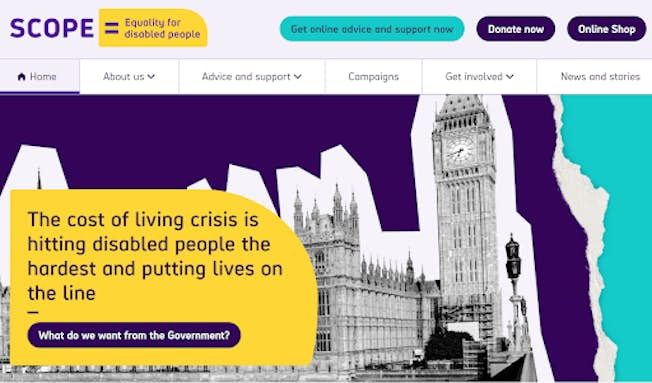
Scope’s website, for example, uses a subtle blend of colors that incorporates white. The colors are used consistently and the turquoise-style button at the top of the screen differentiates from the other purple buttons to highlight the organization’s dedicated to offering advice and support.
When you’re designing a piece of marketing content, you should always use clean and concise visuals to support your text. Airbnb is a good example of a brand using imagery to support its accommodation descriptions.
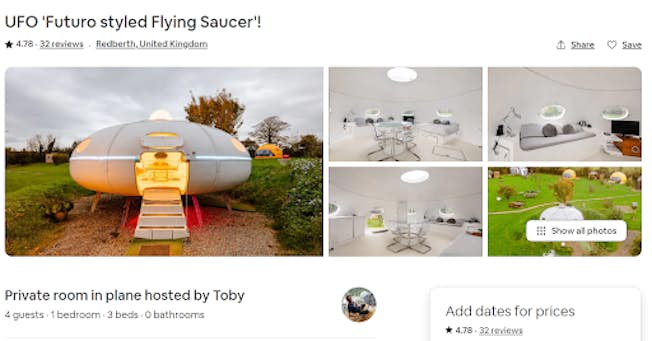
3. Offer your content in a choice of formats
One of the most effective ways of making your digital marketing content is to offer it in a range of formats. Doing so will ensure your consumers can access what you have to offer in a way they feel most comfortable.
Here are some formats to consider:
- Audio reading or transcription features that narrate your text and offer audio prompts as your consumers browse through your content
- Fully descriptive subtitles for any form of video or animated visual content, like Mayoclinic’s informational videos, complete with embedded subtitles and video transcripts:
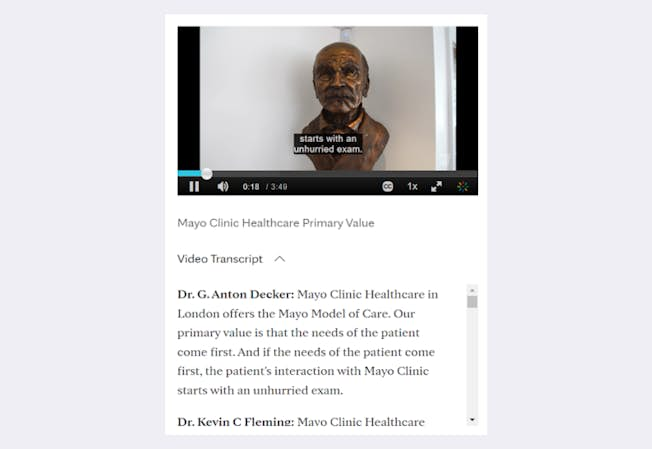
- Extra pieces of user experience (UX) or microcopy that offers practical prompts or descriptions as you hover over every design element (buttons, text, imagery, input boxes, etc.). This can provide clear advice on how to navigate your way through the page. Mayoclinic, for example, offers its users an interactive on-page keyboard to make it easier for its users to search for information on diseases and conditions:
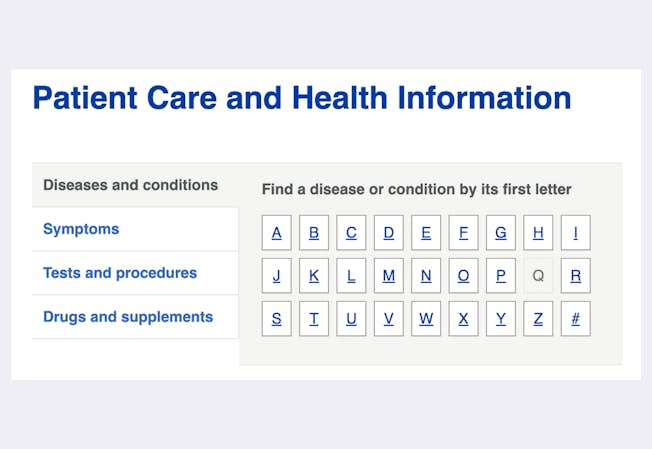
- Use customization options that allow people to change the contrast or brightness of any screen or page they’re browsing
Top tip: Read the UK government's advice on designing for accessibility.
4. Be more aware of digital accessibility
Considering neurodivergent users for your online content is just one part of a greater awareness of accessibility issues for your brand.
The Digital Marketing Institute has been partnering with accessibility experts TPGi to create UX practices that cater to all users of our programs, resources, webinars and other areas. This includes working within official Web Content Accessibility Guidelines (WCAG) and performing a VPAT to ensure conformity to those.
To learn more about digital accessibility, read our three-part series on what marketers need to know, check out our webinar on accessibility, and listen to our podcast on accessibility featuring two guests who speak from their own experiences of autism and sight loss.
Neurodiversity in your workforce
While these tips on inclusive content are valuable, there’s no denying that the very best way to ensure your marketing campaigns and content are fully accessible to neurodivergent users is by having the right people in-house.
The biggest experts on creating inclusive content for neurodivergent consumers are, well, neurodivergent marketers. With neurodivergent marketers on the team, you will implement the tips and adjustments we’ve discussed here in a way that is correct, compliant, and offers real value.
By being more inclusive in their hiring decisions, today’s brands stand a chance of achieving genuinely inclusive marketing content and communications.
Tech colossus Microsoft, for instance, has launched its own neurodiversity (ND) hiring program to attract and nurture neurodivergent talent across the organization. And, thriving Fortune 500 company, Ultranauts’ inclusive approach to onboarding has resulted in a 75% autistic workforce: read more in this post on top companies engaging their neurodivergence.
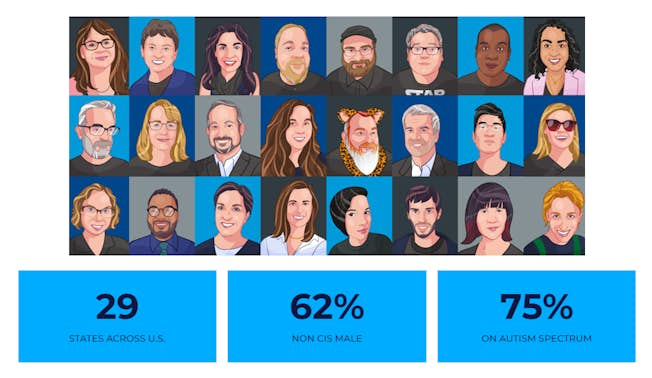
To achieve a culture of diversity and inclusion, it’s important to raise awareness, understand your audience, gather the right insights concerning neurodiversity, and include the right people in hiring or onboarding processes to drive real change.
The majority of the neurodivergent population struggle to find gainful employment. But, by placing a strong focus on encouraging neurodiversity in digital marketing, everyone stands to benefit.
Speaking to the HRreview, CEO of Neurodiversity in Business (NiB), Dan Harris, explains:
“Businesses around the country are waking up to the enormous benefits that having a neurodiverse workforce can bring to the table.
Neurodivergent individuals can bring single-mindedness, attention to detail, innovative thinking patterns, diligence and creativity to bear on any number of practical business matters. But they need better support than is currently available."
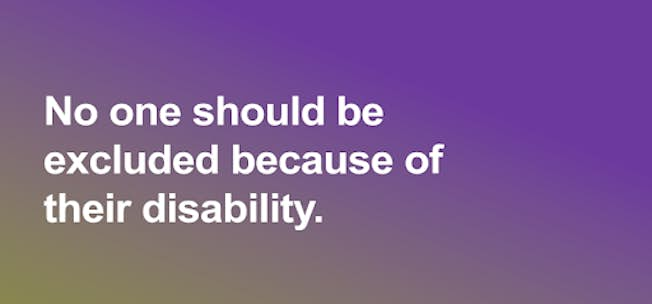
Inclusion should exist in every pocket of society. Every person should have access to opportunities, content, experiences, and services, offline and online. As a modern brand, focusing on inclusion will ensure that most people can access what you have to offer. They will benefit and so will you. It’s a win-win situation.
Related
Upgrade to Power Membership to continue
your access to thousands of articles, toolkits, podcasts, lessons and much much more.
Become a Power Member- Login
- View Courses
- - - -
- Courses
- Resources
- - - -
- My Account
- Change Password
- Logout





